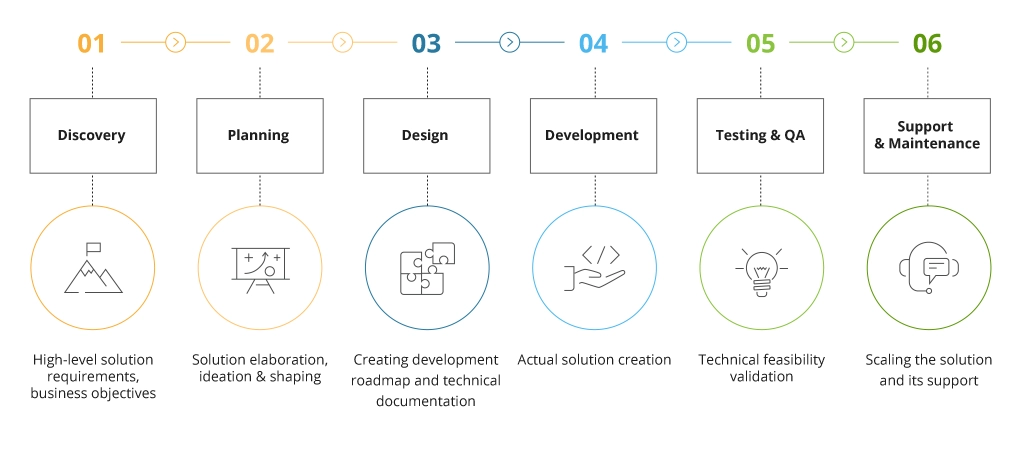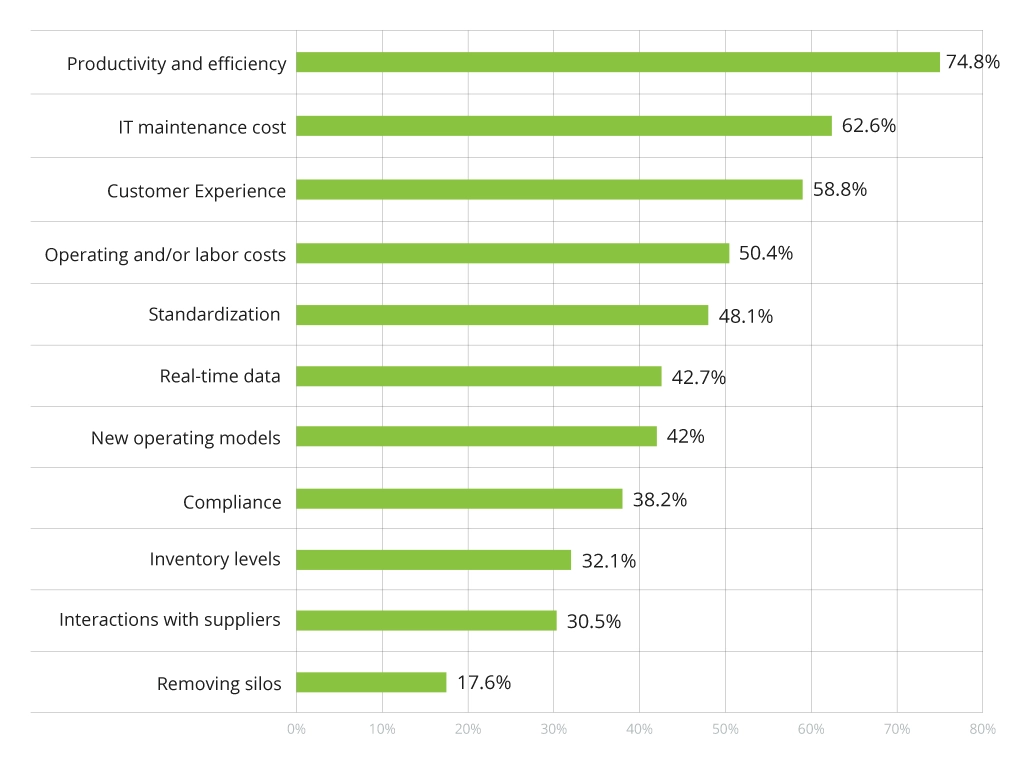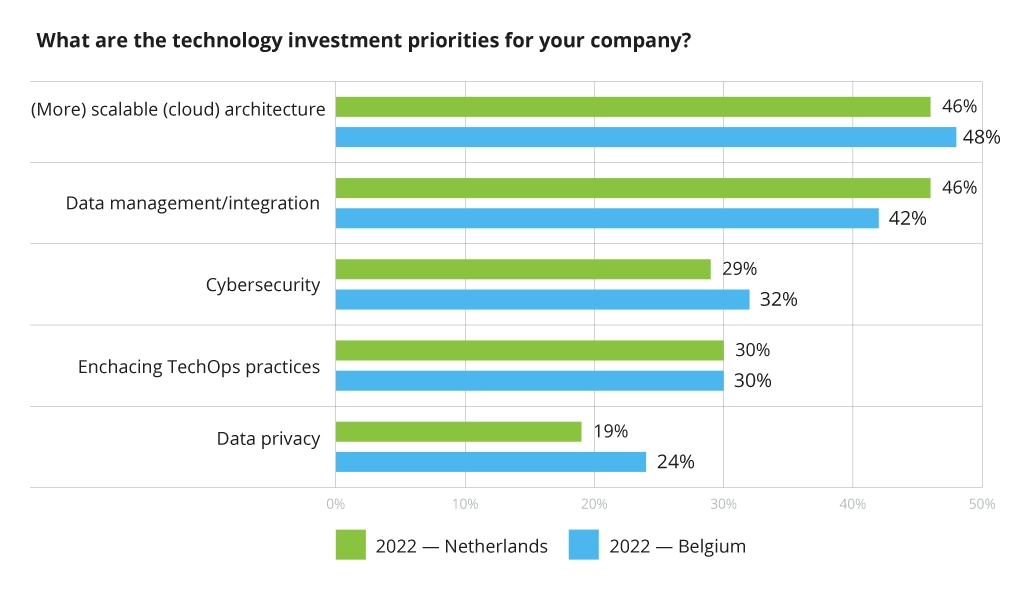Enterprise Software Development: Benefits, Challenges, and Best Practices
What Is Enterprise Software?
Enterprise software is an integral part of any company's computerized ecosystem. It helps to run a business successfully by automating and optimizing different processes, as well as bridging the gap between multiple departments. Whether it is accounting, inventory management, or marketing automation, enterprise software systems lay the foundation for efficient business operations.
Organizations always need a scalable system that can adapt to changing requirements and handle increasingly intricate tasks as they expand. Primarily, this can be achieved by updating or replacing an existing, outdated system with a new one.
In this article, we will cover the basics of enterprise software development and adoption.
Types of Enterprise Software Systems
Enterprise software systems are built to solve specific business problems. The primary purpose of such systems is to help automate business processes, and, as a result, reduce the time it takes employees to perform their jobs. Enterprise software solutions come with a plethora of benefits. For instance, they help increase efficiency and optimize IT maintenance costs.
Enterprise software can be utilized in any industry and is designed for unique company needs, which means you will have to consult with an expert in enterprise software development before choosing this path.
The common types of enterprise software systems that create an array of related products on the market are:
- Business Process Management
- Accounting Software Customer
- Relationship Management (CRM)
- Asset Management
- Content Management System (CMS)
- Master Data Management (MDM).
Such a diversity of enterprise software products is contingent on the fact that the market is primarily driven by the growing number of businesses seeking effective platforms and tools to boost compliance, efficiency, and overall profitability. Additionally, as organizations enter their global reach, their demand for enterprise-grade software increases. Corporate software segment is one of the biggest evergreens — global market revenue is expected to amount to $295.20 billion by 2024.
Main Features of Enterprise Software
The main goal of any enterprise software solution is to manage, integrate, and automate a company’s business processes and operations, eliminating bottlenecks between departments and ensuring a smooth information flow. To achieve these goals a comprehensive enterprise software systems need to possess several key features.
- Integration. Enterprise software must be able to integrate with existing systems and applications within the organization's IT infrastructure to ensure seamless data flow and interoperability.
- Automation. Automation features help streamline and optimize business processes by taking over repetitive tasks, reducing manual intervention, and improving overall efficiency.
- Customization. Organizations can customize enterprise software solutions to match specific business requirements and workflows, allowing them to adapt the software to their needs.
- Analytics and reporting. The platform's reporting and analytics capabilities should make it easy for organizations to generate comprehensive reports, analyze data, and make data-driven decisions. Dashboards and visualization tools are often included in these features.
- Scalability. Software solutions designed for enterprise organizations are capable of handling the complex needs of large organizations and can scale to accommodate an ever-growing number of users and data sets.
- Collaboration and communication. Numerous solutions incorporate tools for collaboration and communication to support teamwork, the sharing of knowledge, and real-time collaborative efforts.
Enterprise Software Development Lifecycle: 6 Main Phases
The key to success in enterprise software development is to choose the right people and processes.
Enterprise software development is a multi-step process that typically involves professionals from multiple divisions. To deliver the best solution for your business, you need to know how each of these teams works together and what their roles are in the project lifecycle. Here is a breakdown of all the key stages and their enterprise systems development services players.

Discovery Phase
The discovery phase lays out both the high-level requirements of your software as well as more specific goals and targets (e.g., increasing sales by 15% by 2023). The team works closely with stakeholders throughout this stage.
During the discovery phase at Infopulse, we perform numerous product specification procedures that allow us to define MVP and post-MVP features, as well as determine business goals, user needs, and scenarios.
Planning
The planning team prepares budgets, timelines, and details required by designers or developers so that they can begin work on designing applications from start to finish without missing any important details along the way. Usually, this includes creating detailed specs for each feature set that shows how it will fit into its larger context within an enterprise application ecosystem, which may include many other features across multiple apps or websites.
Design
Designing includes planning how to implement a system, as well as designing and documenting the details of a software product (including any architectural or engineering decisions). By leveraging UX/UI design and consulting services, you will be able to create a product that is not only aesthetically pleasing but also sustainable and scalable.
Development
The development team is responsible for building and testing your application. This is where the rubber meets the road and where the majority of the time is spent. The time it takes to develop the software depends on several factors, including the system's complexity and whether you have an existing product that can be enhanced or modified to meet your needs.
Testing & Quality Assurance (QA)
Applying a new approach to quality assurance, the QA team tests all code before it gets deployed into production environments to ensure that it works as expected. Software quality assurance services confirm that bugs are detected and fixed before the finished product is released to production. This is why testing occurs at multiple points both during and after development.
Support & Maintenance
The support and maintenance phase of an enterprise applications development is the period between the go-live date and the end of the contract period. Within custom software development, this phase begins with the release of the final product and ends when all support requests have been resolved or until the software expires.
Best Practices for Enterprise Software Development
Though generally applicable to any type of project, the best practices for developing enterprise software systems have their own unique flavor. Here are some tips to keep in mind when you work on creating your own enterprise application.
1. Applying Microservices to Achieve Architecture Modularity
There should be a focus on creating a modular architecture when developing enterprise software systems so that they may be easily integrated into the company's IT landscape. Achieving this goal is easier with the help of microservices because they allow for the modularization of applications.
Case in point. When developing a wholesale risk management solution for one of the top 20 world banks, we chose to build the solution on microservices architecture. We also integrated the solution with many different financial systems already in place and designed it to be scalable and flexible so that it could accommodate future integrations and expansion.
2. Implementing a Cloud Data Storage
The key benefits of cloud data storage for enterprise software development include:
- Cost savings. Cloud data storage typically costs less than traditional on-premises data centers because you do not have to invest in hardware or software maintenance.
- Scalability. You can add more capacity or increase the speed at which your application runs by adding more resources occasionally — without installing new hardware or upgrading the existing one.
- High availability and disaster recovery. If you are using multiple cloud providers, your system will automatically failover if one of them goes offline for any reason (such as an outage). This redundancy helps ensure that your applications are always available for users even when there are problems with one part of their infrastructure.
Therefore, when opting for a cloud solution, you get all the benefits of a traditional hosted solution, but with added flexibility and scalability.
Case in point: Our client, a global agro-industrial company, approached Infopulse for expert knowledge on building complex data warehouses and cloud solutions. As part of our client's digital transformation, we implemented a Microsoft Azure-based Cloud Data Warehouse. As a result, our client accelerated its digital transformation by consolidating its most important data into a single cloud data warehouse, integrating additional ERP systems beyond the already present 1C and SAP systems, and reducing the time it took to implement these changes.
3. Security by Design
Security by design (SBD) is one of five key principles under the NIST Cybersecurity Framework.
This practice aims to ensure that security is built into the development process from the beginning, rather than added on top of an application after it has been developed. Security should be built into every aspect of the software, including business processes, hardware, and software — all the way down to the code level.
The benefits of following an SBD approach include:
- Reduced risk. By integrating security controls into your software from the beginning, you avoid the need to retrofit security later when problems arise during testing or deployment. This helps reduce vulnerabilities in your application and reduces risk exposure for your organization and customers.
- Increased confidence. A well-designed application will have fewer vulnerabilities than one developed without considering security upfront.
- Improved efficiency. The security-by-design approach prevents costly delays caused by system outages or security breaches. However, when implementing security measures such as encryption or tokenization, it is important to make sure that they do not negatively impact performance or availability.
4. A Single Platform with Pre-built Connectors and Many Integration Options
Here are a couple of factors to consider when choosing a data integration platform:
- Pre-built connectors. When it comes to integrating with external sources, having pre-built connectors is incredibly useful. However, it is not enough to simply have them — they also need to be available in the languages and frameworks that you use. For example, if you are using JavaScript/NodeJS, but want to connect with Salesforce or Quickbooks, then you need to make sure that these connectors exist in NodeJS as well.
- Many integration options. A single platform does not necessarily mean that there will only be one way of connecting with other systems — it can also mean multiple ways of doing so. That way, if one fails or becomes too expensive, another option should still be available (and vice versa).
Case in point. As part of our collaboration with a transnational agro-industrial conglomerate, we implemented a SAP S/4HANA platform with support for 300+ users, giving them access to a comprehensive set of tools for efficient business administration. Migration from legacy systems, standardization of master data, and significant increases in the general effectiveness and accuracy of company business operations supported by rapid re-engineering — all thanks to the integrated system.
5. Cloud-Native Approach
There are various reasons for enterprises to adopt a cloud-native solution, as it provides a new way of building and managing software in the cloud.
Cloud-native applications are designed to run on a cloud platform and can be automatically scaled up or down as needed.
Such applications can be deployed as often as desired without downtime. This allows developers to quickly fix bugs or add new features without going through lengthy testing cycles before deploying changes into production environments.
Case in point. Infopulse successfully completed a data center migration to Microsoft Azure for a global mining and metals company. This massive cloud migration necessitated careful planning and precise execution of the migration strategy. There were positive effects across the board as a result of this transformation, including lower total cost of ownership and higher output.
6. Finding the Right Talent
To create enterprise-level software systems, you need professionals who have expertise in your industry and can deliver what your business needs.
One way to do this is by leveraging custom software development services instead of augmenting staff. A software development company can help with this by providing an experienced team of specialists that can work on your project from start to finish. The key is finding the right company for you and your business goals — this gives you more time to focus on developing your product while also allowing you to save money on hiring full-time employees or freelancers.
Challenges of Custom Enterprise Software Development
Generally, the implementation of an enterprise software system means transferring a business process to a new system. It is often a complex and drawn-out project. Here are some of the complexities that can arise during enterprise software implementation.
Lack of Architecture Scalability and Fexibility
The ability to process, store, and manage large amounts of data is the norm for today’s IT applications. However, most current architectures are not optimized for this type of workload due to their linear scalability approach (where all nodes in the cluster have the same capacity). If you are planning to build an application with high-performance requirements, you will need a more advanced architecture based on Hadoop clusters with dynamic allocation of resources across clusters. For example, you could completely reimagine the solution architecture like Infopulse did for the Coaching & Consulting Platform.
According to the Deloitte Scale-Ups Confidence Survey, more scalable architecture is the top technology investment priority for companies (in Belgium and Netherlands):
Growing Security Threats and Risks
Today's connected world means that cybercriminals are constantly inventing new ways to gain access to your systems using different types of attacks such as ransomware or malware injections into web pages via infected ads displayed on legitimate websites, etc. For your enterprise software system to be secure, it must have robust security features such as two-factor authentication (2FA), multifactor identification (MFA), and encryption across all its layers including backends and frontends, that can prevent hackers from stealing sensitive information while it is being processed inside those systems.
Data Migration and Integration
When migrating data from one system to another, you have to consider how long it will take and how much effort will be needed. You also need to determine how much manual work is required and whether any of that manual work can be automated using a migration tool or other methods. The same goes for data integration — you need to make sure that the new system can integrate with your existing systems without any issues or delays in data sharing. If there is no way to integrate seamlessly, you may need to investigate other options such as using APIs or developing custom code for each application or database.
Change Management
The complexity of adopting enterprise software systems is often overlooked in change management processes, leading to complications once the system is up and running and in daily use by your organization's employees. Projects benefit greatly from change management because it ensures that any changes are communicated effectively throughout all levels of management, keeping everyone up to date and on the same page as the project progresses at every stage.
Integration with Other Systems
Enterprise software is designed to integrate with other systems to provide better information access and control over data flows between systems. This means they need to be compatible with your existing software as well as any other systems used by employees or partners. Therefore, we always make sure there is adequate time built into the implementation schedule for testing these integrations, as well as managing data integrity issues if things do not go according to plan.
What Is the Cost of Enterprise Systems Development?
There are several factors that affect the cost of enterprise systems development services. Among these are the complexity and scale of the system, the features and functionality needed, and the level of customization required to meet business objectives.
In addition, the choice of the technology stack, the expertise and experience of the development team, and the duration of the development process all affect the cost of enterprise application development.
Other costs to keep in mind include ongoing maintenance, integration with existing systems, and training for end users. Organizations should also consider potential risks and unforeseen challenges that may arise during business software development.
Final Thoughts
The ever-constant race for newer and better technologies has proved useful for businesses in achieving growth and success. As a result, the inevitable spread of innovative technologies across industries makes it necessary for companies to invest in enterprise software development and to develop enterprise applications for their specific needs. There are many advantages to investing in these systems, and the company can reap the benefits from them.
Building an enterprise software system is a complex process, but it can be approached in a variety of ways. In this article, we have looked at how to do it and how this approach differs from others. Overall, it is essential to find the right balance between simplicity and flexibility for your system to work well with other systems as well as its users.
FAQ
What is enterprise software development?
Enterprise software development involves creating software to meet the specific needs of large organizations. Enterprise applications aim to simplify operations, such as managing customer data or supply chains, and often integrate with existing systems.
What are the reasons for implementing enterprise software systems?
Companies implement enterprise software systems for various reasons. Some of the most common include improving efficiency and facilitating processes, gaining real-time data-driven insights, and ensuring compliance with regulations. In addition to helping businesses make better decisions, these systems can help them stay abreast of industry standards.
What is the difference between software development and enterprise software development?
Regular software development caters to a broader audience, like individual users or smaller teams. In contrast, enterprise software development creates custom solutions for large organizations, focusing on their specific needs and complex workflows, like managing finances or logistics across a global network.
What is enterprise software most often used for?
Enterprise software is most commonly used to manage various core functionalities of a large organization, from customer relationships to enterprise resource planning.
![How to Build Enterprise Software Systems [banner]](https://www.infopulse.com/uploads/media/banner-1920x528-how-to-build-enterprise-software-systems.webp)



![Power Apps Licensing Guide [thumbnail]](/uploads/media/thumbnail-280x222-power-apps-licensing-guide.webp)
![Super Apps Review [thumbnail]](/uploads/media/thumbnail-280x222-introducing-Super-App-a-Better-Approach-to-All-in-One-Experience.webp)
![ServiceNow and Third-Party Integrations [thumbnail]](/uploads/media/thumbnail-280x222-how-to-integrate-service-now-and-third-party-systems.webp)
![Cloud Native vs. Cloud Agnostic [thumbnail]](/uploads/media/thumbnail-280x222-cloud-agnostic-vs-cloud-native-architecture-which-approach-to-choose.webp)
![DevOps Adoption Challenges [thumbnail]](/uploads/media/thumbnail-280x222-7-devops-challenges-for-efficient-adoption.webp)
![White-label Mobile Banking App [Thumbnail]](/uploads/media/thumbnail-280x222-white-label-mobile-banking-application.webp)

![Mortgages Module Flexcube [Thumbnail]](/uploads/media/thumbnail-280x222-Secrets-of-setting-up-a-mortgage-module-in-Oracle-FlexCube.webp)
![Challenges in Fine-Tuning Computer Vision Models [thumbnail]](/uploads/media/thumbnail-280x222-7-common-pitfalls-of-fine-tuning-computer-vision-models.jpg)
![Pros and Cons of CEA [thumbnail]](/uploads/media/thumbnail-280x222-industrial-scale-of-controlled-agriEnvironment.webp)